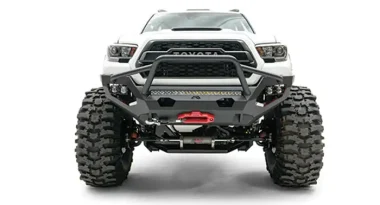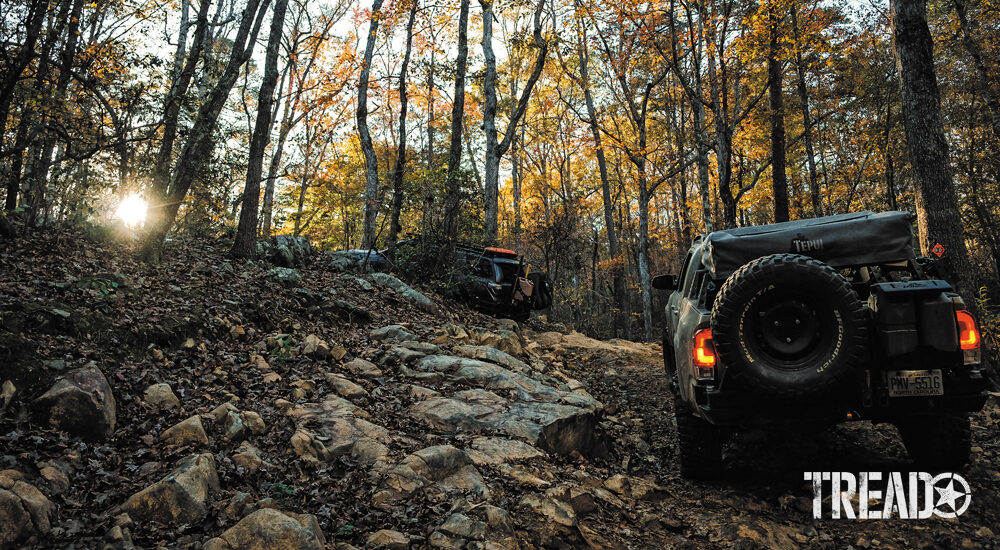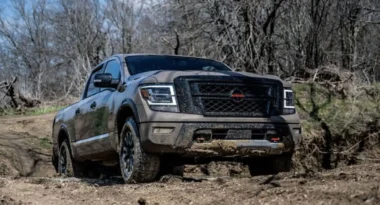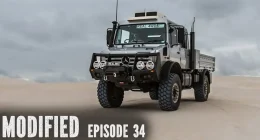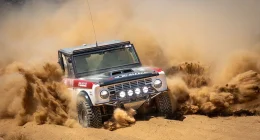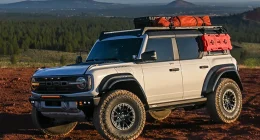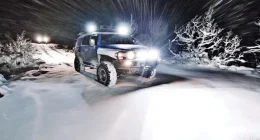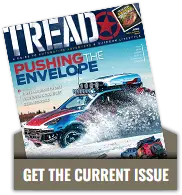Wild Kenya
Stunning Wildlife Across an Expansive Kenya Landscape Met High Expectations
Kenya; the slight incline is nothing to write home about—although with a continuous light drizzle, the clay surface has all the traction of an ice skating rink. The broken front driveshaft is still in a storage locker in the back of the Jeep, so I have no chance with only the rear wheels spinning. I soon find it impossible to move either forward or backward, and in short order, I slide sideways into the ditch on the side of the road. The ditch is not huge, however; even with four-wheel drive, I doubt the Jeep could haul its 6,000-pound bulk up and out under its own power.
For the second time in only weeks, I unspool the winch line and get to work recovering my Jeep.

Into Kenya
Winding my way along a small dirt road glued to the side of mighty Mount Elgon a few weeks earlier, the tiny villages remind me strongly of rural South America. It’s a stunning slice of Uganda, and I’m concentrating so hard on keeping the Jeep on the track I forgot to take a single photo all day.
I arrive at the small border post at Suam River and immediately like what I see. There are just a couple of buildings, a few vehicles, and a handful of people waiting in the shade. Clearly this is a very sleepy crossing, exactly the kind I seek out. After the five-minute process to stamp myself and the Jeep out of Uganda a friendly guy wanders over and offers to change my remaining Ugandan shillings. I’m not sure about the exchange rate he offers, and he is kind enough to find a copy of today’s newspaper to show me the official rate so we can both be certain we are getting a fair deal.
“We’re on the move before sunrise and within an hour we’ve seen multiple lions, elephants, zebras, and, of course, giraffes.”
I drive a hundred yards and cross a small wooden bridge over the Suam River before the now very familiar process is repeated on the Kenya side. The head man at immigration is out for lunch, which gives me a chance to eat and chat with the friendly officers who are standing around. When the boss returns I buy a visa for $50 without a problem, and the main man at customs issues me a 14-day Temporary Import Permit for the Jeep at no cost. He is kind enough to explain I can easily extend it for another 14 days in downtown Nairobi if I wish.
Driving into Kenya, African country number 31, is another painless and friendly border crossing.
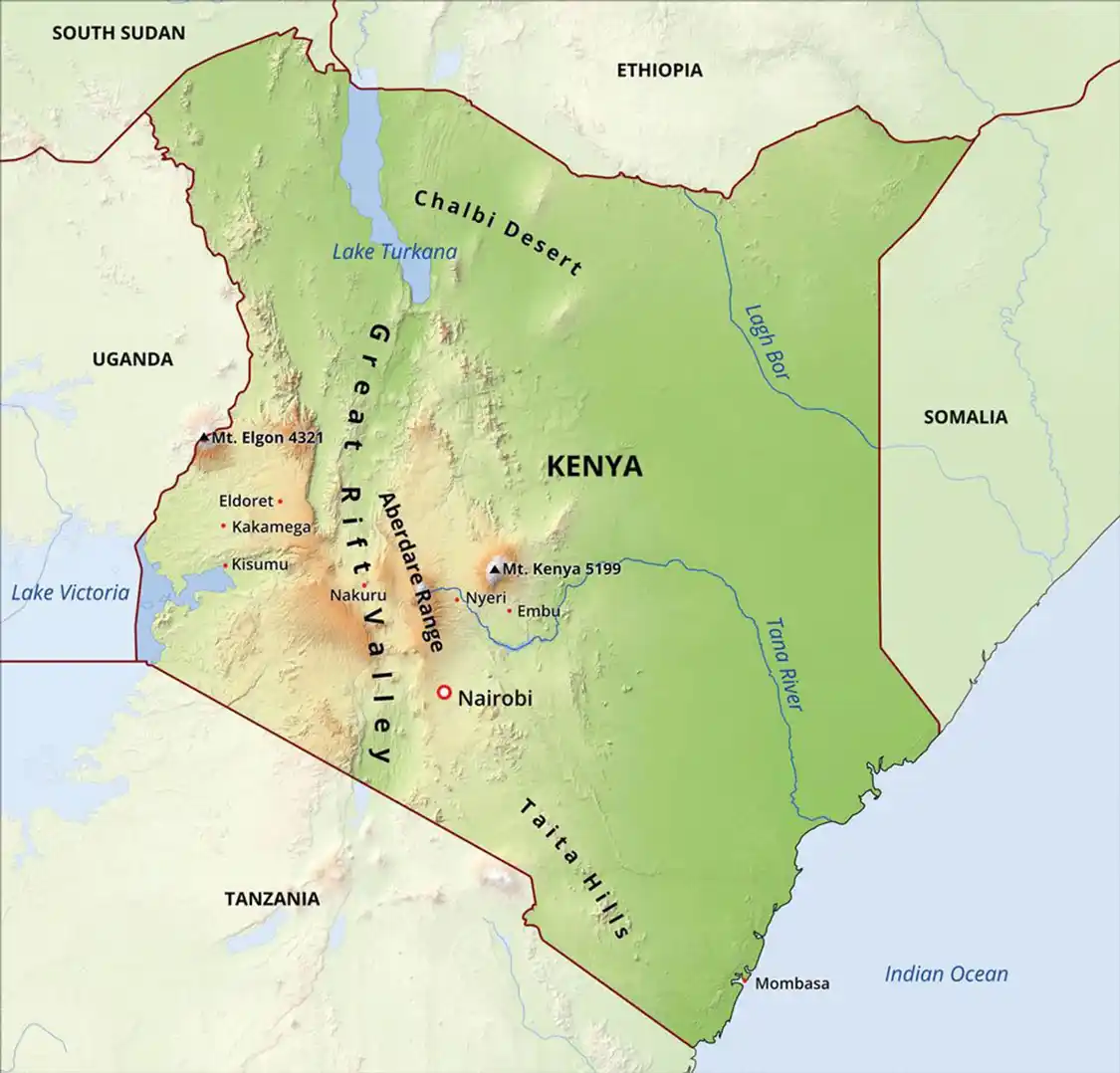
Kenya Quick Facts
Capital City: Nairobi
Population: 49 million
Size: 224,000 square miles (slightly smaller than Texas)
Languages Spoken: 2 official (English, Swahili)
Currency: Kenyan shilling
Independence from England: December 1963
Maasai Mara National Park
The main road into Maasai Mara National Park in Kenya sees an enormous amount of guided tourist traffic and is being completely rebuilt from the ground up. As is common throughout Africa when roadworks are underway, traffic is forced to drive off the side of the road, often on horrendously corrugated and broken tracks that are ignored in favor of building the new road. The size of the corrugations is so impressive, I stop to air down to my usual 20 psi, and then stop again 30 minutes later to go down to 15 psi. Crawling in First gear for hours is tedious, though the stunning open plains stretching to the horizon make up for it.
I camp just outside the entrance gate where a local Maasai guide offers to show me through the park for $10. In many parks I have driven aimlessly on my own with no clue where to find the best wildlife, so I make a snap decision and accept his offer, a first for me.
We’re on the move before sunrise and within an hour we’ve seen multiple lions, elephants, zebras, and, of course, giraffes. Utterly alone we sit as five male cheetahs walk directly toward the Jeep while on a morning hunt. In all my time in Africa this is the first time I have seen cheetahs in the wild and they are just as special as I had imagined. A few hundred meters away a lone leopard hides in the bushes, and when I park the Jeep it again walks directly toward us, providing the best close-up to date.
In the early morning we encounter a herd of wildebeest looking anxious, and the guide of another safari vehicle explains a lion is hiding nearby in the grass stalking them. While we sit and wait, an elephant mother and baby wander into the scene, and more and more wildebeest converge and trample around. Waiting with bated breath, I can’t help but feel I have stepped into a National Geographic documentary.

Finally, the lioness springs forward, though the distance she needs to cover is too great and the wildebeest are easily able to evade her. Not far away we find the rest of the pride napping in the shade—apparently they’re all too lazy to bother chasing food today.
In the afternoon, we explore far and wide, finally arriving at the southern boundary of the park, before actually crossing the International border with Tanzania. I won’t be getting a stamp in my passport for today’s crossing.
Here in the southern region of the park tens of thousands of wildebeest mill about in enormous herds, slowly grouping up to cross the river. I’m late for the world-famous migration, though there are still many animals and my guide says thousands did cross just yesterday. It’s a stunning sight, and the cross and hippos in the river add to the whole scene, which is again straight out of National Geographic.
My Maasai guide is so good at locating wildlife that over the course of the day we encounter so many lions that I actually stop taking photos of them—the first time this has ever happened on the continent. It’s an enormous day of wildlife spotting and stunning landscapes that I won’t soon forget.

Stuck in the Ditch
The following morning I’m up early and make good time until I slide into the ditch in the light drizzle. With the Jeep clearly not going anywhere, I pull out my recovery gear and get to work. The only option is a telephone pole on the far side of the road—far from ideal, but it will just have to do. Soon 4×4 vehicles full of locals arrive on scene, and immediately, multiple people tell me exactly what to do, and of course they are all suggesting different things.
The winch has no problem pulling the Jeep up and out of the ditch, though the angle of the pull means it is now across the road at 45 degrees, and I’m still unable to drive forward or back on the slick clay. The locals are clearly familiar with this problem and soon a group of men are able to push the rear of the Jeep straight and I reverse slowly and carefully down the slick incline.
“Even with four-wheel drive, I doubt the Jeep could haul its 6,000-pound bulk up and out under its own power.”
While I’m putting away recovery gear the scorching African sun shines strong, and soon not only is the road bone dry but it even returns to its usual dusty conditions. An hour later the surface severely degrades until I’m in low-range Second gear to descend. I’m immensely happy I didn’t tackle this section in the rain as I am certain I would not have gotten off so lightly as simply stopping in a ditch.
The green grass and wood-fired hot shower are a welcome sight on the shores of Lake Naivasha. I keep a close eye on the thieving monkeys that repeatedly climb on the Jeep. And falling asleep to the sound of grunting hippos is now a familiar and comforting lullaby.

Jeep Maintenance & Repairs
Eager for a huge round of maintenance and repairs, I venture into the heart of the capital of Nairobi, an enormous and modern city. Ex-pat Chris runs Jungle Junction, a campsite, workshop, and restaurant combination that is the most famous of all overlander haunts on the East Coast of Africa. Every night other overlanders driving and riding around Africa congregate here, making Jungle Junction a fantastic place to get up-to-date information on the political situation I will face in Ethiopia and Sudan in the coming months. I also must obtain visas before I can cross into these countries, making this the perfect place to unwind, work on the Jeep, and plan and prepare for the final leg of the expedition to Egypt.
Over the course of a week I complete another huge round of maintenance and carefully check over the damage from the flop in Uganda. I change the engine oil, differential oils, perform a tire rotation, and replace the front brake pads. I’m extremely happy to install a new TerraFlex CV joint on the front driveshaft. This High-Angle Rzeppa CV Joint has been specifically designed with the increased driveshaft angles that come with a lifted JK Wrangler. Now I’m confident this issue has been permanently put to bed and I will be able to rely on 4×4 for the rest of the expedition. The duct tape holding on the front fender seems to be doing just fine, and everything on the suspension checks out OK. I’m still not sure if I have actually bent the notoriously weak D44 front axle or just unseated an axle seal. For now I will just keep a close eye on the leak and see how it develops.
While in the city, I take a few rest days to enjoy the sights, locking lips with a giraffe and watching the daily feeding of baby elephants at the nearby elephant and rhino orphanage. It’s extremely disorienting to walk into a huge shopping mall that could be in any developed country anywhere in the world.

Lake Turkana to Ethiopia
The main border from Kenya to Ethiopia at Moyale has devolved into a war zone in recent weeks with gun fights, burning buildings, and dead bodies left in roadside ditches. I’m learning tribal conflicts in Ethiopia are very serious business.
The extremely remote crossing at Lake Turkana is a lot more interesting, and my research reveals the route is so remote there is actually no legal border to cross. With no immigration or customs at the actual border, I get myself and the Jeep stamped out of Kenya while still in Nairobi. A first for me, I’m legally stamped out a full week before I will physically leave the country.
I’m awe struck when I crest a rise and the lake comes into view for the first time. The massive lake is dotted with intermittent islands and the shoreline is nothing but barren rock. As I drop down to lake level and continue north on the rocky track, I’m staggered to see locals living in this extremely harsh environment. They are living in handmade round huts, and fishing appears to be their main food source. The lake is famous for having the highest density of crocodiles on the planet, though the fishermen are not deterred. I see them repeatedly wade up to their chests retrieving nets. I can’t help but wonder how many are killed each year.

The hours roll on and the road surface continually changes from rock to sand and even to an occasional mud section. The landscape is extremely barren, and I’m not at all surprised when I see camels wandering around searching for what food they can find.
In the scorching 113 degrees F heat I stop for lunch under the shade of a rare tree before pushing onto the entrance gate of the extremely remote Sibiloi National Park. This park is famously known as the Cradle of Humanity, and it was on the shores of Lake Turkana where the oldest human remains ever to be discovered were unearthed, commonly called Lucy.
The rangers at the entrance gate explain they are lucky to see one lone vehicle per day and can sometimes go a week without a single vehicle passing. Absolutely nobody lives in the park, and with only one vehicle per day passing, it’s unlikely I will see a single soul while here.

I’m torn about going directly north through the middle of the park or cutting west to the lakeshore, and eventually settle on the north. After only 10 miles, it’s clear this route is never used, and I find myself in low-range First with both differential locks engaged to pass one particularly sticky mud section.
At night I am in awe of the immense landscape and solitude. During the day, the temperature quickly climbs well over 110 degrees F and what little vegetation exists provides no escape from the scorching sun.
All the rivers are dry, though the crossings are at least a hundred yards wide and cut deep into the rocky landscape. At one huge crossing I lose the track, and after walking around for 40 minutes searching, I start to lose the light to another approaching thunderstorm. I make camp high on the bluff above the riverbed and am treated to a stunning display of clouds and distant storms—though I only get a few drops of rain.

At 5 in the morning, long before sunrise, the temperature is still a balmy and humid 79 degrees F, and I know I’m in for another scorching day. I decide the smart choice is to backtrack and take the track toward the lake. When I look carefully, I can see very faint tire tracks in the sandy sections, and I feel a little happier to know vehicles at least sometimes pass this way. On and on the track winds, with sand becoming more and more common as I approach the lakeshore. Finally, I hit the lake and swing north before crossing many sandy dry riverbeds and washouts. Hour after hour I continue, slowly moving away from the lake before climbing a rocky outcrop high above the lake.
After days of slowly crawling north on the rocky track, I cross the dotted line on my GPS into Ethiopia. There are no signs and nothing to indicate I again need to change over to drive on the other side of the road. I’m fairly confident I need to move over, and when I spot the first vehicle for days the steering wheel on the left is a dead giveaway. I also can’t help but notice characters on the license plate that are not written in English. It soon becomes very clear I am no longer in East Africa, but have firmly moved into North Africa.
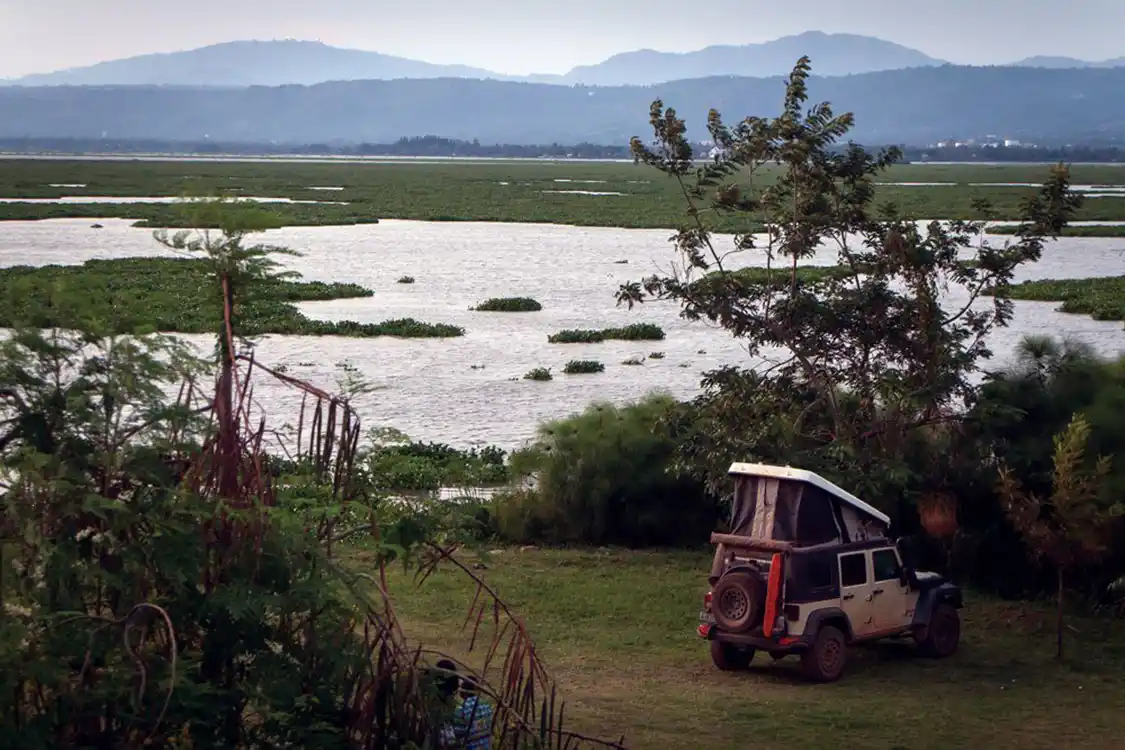

Wild Kenya
Famous for stunning wildlife and immense National Parks, Kenya certainly lived up to my high expectations. Unexpectedly, I was able to explore the most barren region of East Africa I have seen to date, getting further from civilization since the immense Namib and Kalahari Deserts of Southern Africa.
With friendly locals, great street food, and cheap local beer, I have throughly enjoyed my time in Kenya. Now again with 4×4, I’m excited for the final push north to Egypt, and the final leg of my African expedition.
For more tales of faraway travels, follow adventurer Dan Grec on his website theroadchoseme.com and on Instagram @theroadchoseme.

Editor’s Note: A version of this article first appeared in the May/June 2020 print issue of Tread Magazine.



